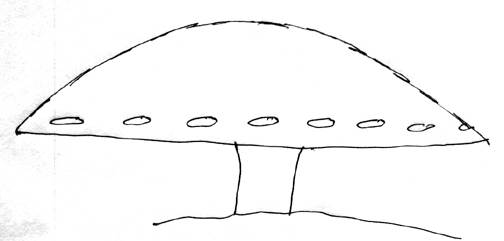Space Penguins

illustration by Claude Edwards, 1967
Origins:
Summarized succintly per the civilian-based non-profit organization National Investigations Committee On Aerial Phenomena (NICAP) records:
Feb.14, 1967; Jefferson City, MO
7:00 a.m. CE-III. A disc-shaped object was seen resting on a shaft in a field. Small beings were reportedly moving around rapidly beneath it. They disappeared behind the shaft, the object rocked back and forth, took off, and sped away. (UFOE II, p. 327)
Illustration of the spacecraft, by Claude Edwards:

More details are shared in a report by Ted Phillips, for the Aerial Phenomena Research Organization (APRO) and Midwest UFO Network (MUFON):
Date: February 14 1967
Time: 0700A
Claude Edwards, a 64-year old farmer, saw a gray-green dome shaped object about 15 feet wide in his fields; he thought at first it was a parachute, but as he neared it he could see that it was resting on a shaft about 18' wide that extended downward from its base. Around the edge of the dome were a number of bright-multicolored lights of oblong shape. Beneath the object were visible several entities less than a meter tall, also gray-green in color, moving about rapidly, with quick moving "lever or arms," very wide-set eyes, and no visible legs. He also noted a protuberance where the nose and mouth would have been. The witness walked to within 30 feet and threw two stones at the object, which bounced off an invisible wall between him and the object. Walking up to within 15 feet, he was able to feel the pressure of this invisible barrier. The surface of the object was seamless, like gray-green silk. By this time the little creatures had disappeared inside the object, and it rocked back and forth several times, then took off silently, disappearing towards the northeast within seconds. He further described the creatures as appearing "like a penguin, not human without a visible neck." The object, "it just looked like a big shell, grayish-green in color. There were still ground traces at the site three months after the encounter. At the site the soil was extremely dehydrated in contrast with the surrounding soil. At the center there was a depression 20mm deep sloping to 30mm in the central area.
Photo of hole made by one of landing arms, by Ted Phillips:
